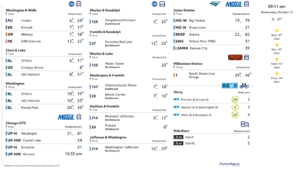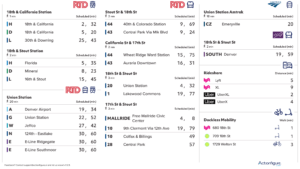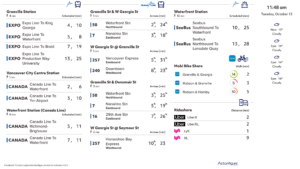Why is congestion pricing happening?
New York City is infamous for its congestion, consistently ranking in the top 3 worst cities for traffic. Traffic on NYC’s bridges and tunnels has fully recovered from the pandemic and is breaking records. Something needed to change.
To address congestion, the MTA (Metropolitan Transportation Authority) has implemented the Central Business District (CBD) tolling program, which reduces the number of vehicles in congested areas and secures funding for the city’s public transit infrastructure.
The program charges an additional toll to cars entering the most congested part of NYC, the Central Business District (CBD), stretching from Manhattan’s 60th Street down to the southern tip of the Financial District. The MTA’s lofty goals for this program include reducing the number of vehicles in the CBD by 17% (roughly 150,000 vehicles) and raising $15 billion to help modernize the city’s aging public transit system.
When did congestion pricing go into effect?
The program began on January 5th, 2025, following the MTA board’s approval and the installation of tolling infrastructure in Manhattan.
Before these big steps could be successfully implemented, however, congestion pricing had a few hurdles to overcome. NYC congestion pricing faced six different lawsuits from various government officials and groups, including the State of New Jersey, the United Federation of Teachers, and the Staten Island borough president. Lawsuit rationales included the lack of exemptions for certain individuals, financial burden on drivers, and potential environmental downsides. These legal challenges have been resolved and the program has begun.
Who will get charged, how much, and how often?
-
- Personal vehicles: Charged an additional $9 each day when they enter the CBD area during peak times, consisting of weekdays from 5 am to 9 pm and weekends from 9 am to 9 pm.
-
- Off-peak rates: Roughly 75% less than peak rates.
-
- Taxis and Rideshares: An additional $0.75 per ride for yellow taxis and $1.50 for rideshare services like Uber and Lyft.
-
- Trucks: Small trucks are charged $14.40 during peak periods, while large trucks face a $21.60 toll.
- Trucks: Small trucks are charged $14.40 during peak periods, while large trucks face a $21.60 toll.
-
- Current tunnel tolls will remain, although the MTA will rebate some of the current tunnel tolls as a “crossing credit.”
-
- See the “Additional information” section below for all the details.
Recent developments:
Since its implementation, the congestion pricing program has faced mixed reactions. Some drivers have attempted to avoid tolls by obscuring their license plates, leading to involvement of the NYPD. Additionally, neighborhoods just outside the tolling zone have experienced heightened parking demand as drivers seek to avoid entering the CBD. For the most current information and detailed toll schedules, please refer to the MTA’s official website.
How can I prepare my company for this change?
These controversial changes are the biggest change to hit New York drivers in decades, and will affect commuters who regularly drive into the city. Someone who drives alone from New Jersey to Manhattan through the Holland Tunnel during rush hour, who currently pays $4000 in tolls, will now pay an additional $2600 for a total of $6600. That’s $25 per workday.
Some employees might see the congestion charge as just one more barrier to being in the office, or as the basis for demanding direct driving or parking subsidies. Given the importance of positively engaging your workforce around commuting, the best practice is to identify and engage with affected employees, but to take action in ways that equitably benefit your whole workforce.
- Prepare. Identify employees who will be affected by the congestion charge because of their route and their travel mode. It’s best not to stereotype based on an employee’s home location or because they park in a garage – what matters is whether they have public transit options that work for them. Using Actionfigure Foresight, you can analyze your entire workforce in minutes and identify everyone whose commute will be affected by NYC congestion pricing. You can see what their best transit options are, and how they will affect commute times (and commute cost and carbon emissions).
- Communicate. Showing you understand employee challenges will go a long way. Acknowledge the upcoming changes, and show that you are being proactive to address them. Actionfigure Screen is the easiest tool for communicating with employees about transportation: a digital office screen showing real time transit and traffic information, service alerts, and informational messages of your choice. Wielding this vital information, commuters can easily and efficiently navigate their daily journeys.
- Seize the opportunity. New York only works because people move on public transportation, and research always shows that drivers are less happy than transit commuters. To encourage transit commuting, make sure your employees are saving money by taking full advantage of pre-tax commuter benefits that can save them 30% – many employees fell out of the habit during the pandemic.
In the long term, many more commuters can turn to public transportation as a more affordable, environmentally friendly, and convenient way to travel. Your employees care about sustainability, and encouraging them to use public transit will decrease your carbon footprint just in time for upcoming changes to sustainability reporting that will make employee commute emissions tracking mandatory.
It’s not going to be painless, but ultimately NYC congestion pricing is a huge step forward for the city’s quality of life: reduce vehicular congestion, cut down on pollution, and provide funding to enhance and improve the MTA’s service for decades to come. If we’re proactive and use the right tools, we can manage the negative impacts of the transition and take advantage of the positives.
Actionfigure can quickly and easily analyze your company’s exposure to congestion pricing and help you identify solutions. Fill out the form below and we will get in touch!
Additional information on toll pricing and timing structure
Personal vehicles will be charged an additional $9 to enter this area, with other vehicles like large trucks could be charged up to $21.60. The tolls will even affect riders of taxi and rideshare services like Uber, charging a respective $0.75 and $1.50 per ride.
These prices only apply to peak times, consisting of weekdays from 5am to 9pm and weekends from 9am to 9pm. Off-peak rates are roughly 75% less, charging personal vehicle tolls around $2.25. Regardless, tolls will only be charged once a day, meaning those who travel in and out of the CBD multiple times in a single day will only be charged the first time they enter.
These tolls will automatically be collected through E-ZPass by automatic toll readers dispersed throughout the city. Those who do not use an E-ZPass will be mailed their bills and forced to pay substantially higher prices – $13.50 for passenger vehicles during peak hours, instead of the usual $9.
Below are the pricing tables for different vehicles with and without E-ZPass at peak and off-peak times, read more here.
Pricing Table with E-ZPass
| Vehicle Type | Peak Congestion Fee | Off-peak Fee |
|---|---|---|
| Passenger vehicles/cars | $9.00 | $2.25 |
| Taxis | $0.75 | N/A |
| Rideshare (Uber, Lyft, etc.) | $1.50 | N/A |
| Small trucks (box trucks, moving vans, etc.) | $14.40 | $3.60 |
| Large trucks | $21.60 | $5.40 |
| Motorcycles | $4.50 | $1.05 |
Pricing Table without E-ZPass
| Vehicle Type | Peak Congestion Fee | Off-peak Fee |
|---|---|---|
| Passenger vehicles/cars | $13.50 | $3.30 |
| Taxis | $0.75 | N/A |
| Rideshare (Uber, Lyft, etc.) | $1.50 | N/A |
| Small trucks (box trucks, moving vans, etc.) | $21.60 | $5.40 |
| Large trucks | $32.40 | $8.10 |
| Motorcycles | $6.75 | $1.65 |
Are there any exemptions to the tolls?
Given MTA’s pricing model above, some groups may be surprised to find that few exemptions exist. Despite arguments from these groups, public sector employees (police, teachers, transit workers, etc.), residents of the CBD, electric vehicle drivers, and individuals driving to medical appointments will have to pay full congestion pricing.
The only full exemptions apply to emergency vehicles, government vehicles, like snow plows or school buses, and some commuter buses traveling into the area. Additionally, low-income drivers who make less than $50,000 a year can apply for a 50% discount on the peak congestion charge for trips following their first 10.
The MTA has also enacted a small “crossing-credit” in hopes of lessening the financial burden of paying both the new congestion fees and existing tunnel tolls. Thus, drivers entering NYC through one of Manhattan’s four tunnels will receive credit, essentially a discount, towards their toll. Specifically, drivers using the Lincoln or Holland tunnel will receive the following credits during peak times: $3 for passenger vehicles (off the peak toll of $9), $7.20 for small trucks, $12 for large trucks, $1.50 for motorcycles. Drivers through the Queens-Midtown or Carrey tunnel will receive half of the above credit. Drivers over the George Washington Bridge will not receive a credit.
And for those searching for geographic loopholes to NYC congestion pricing, traveling on the FDR Drive and the West Side Highway/Route 9A, as well as The Battery Park Underpass and the surface roadway of the Hugh L. Carrey tunnel will exempt drivers from the toll.




